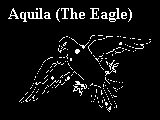|

Aquila means "eagle," and the pattern of stars in this constellation
can be easily imagined as a soaring eagle with outstretched wings. It is visible from both the Northern and the Southern hemispheres.
Some of the legend surrounding Aquila involbes its neighboring
constellations. In modern sky tales, most of which date to the Romans, Aquila is said to represent the mythological eagle
that carried Ganymede to the heavens to become the cupbearer to the gods. It is seen as swooping down toward the constellation
Aquarius, which represents Ganymede, or flying through the Milky Way to attend Jove. In the legend, Jupiter needed to replace his
cupbearer, Hebe, either because she stumbled while serving at a banquet or because she married Hercules (the constellation
Hercules forms the northwestern border of Aquila). Ganymede, a young Trojan prince noted for his beauty and purity, was selected
to replace Hebe, and an eagle -- Aquila -- was sent to bring him to Mount Olympus. The constellation Sagitta (the Arrow),
above the wing of Aquila, is said to represent the arrow of Eros -- perhaps the arrow that led Hebe to Hercules.
|
|

Auriga is a constellation of the Northern Hemisphere. Auriga, Latin for "charioteer," lies west of Perseus far north of the celestial
equator. Auriga is a significant constellation, both for its astronomical objects and for its ancient and complex mythology.
The pentagon-shaped constellations straddles the Milky Way almost directly overhead and lies notheast of Taurus, due north of Orion, and northwest of Gemini.
Auriga is often depicted as the torso of a charioteer holding
a bridle and whip in his right hand and cradling Capella, or the "she goat," on his left arm. Two kids, the offspring of Capella,
rest on his wrist of forearm.
Romans called the constellations Erichthonius, their translation
of the Greek equivalent. Erichthonius was a legendary king of Athens and son of Vulcan, who invented the four-horse chariot
and as a result became a favorite of Jupiter. Other legends associate Auriga with Myrilius, who served as charioteer to king
Oenemaus. One of Myrtilius' duties was to race to the death any suitor of the king's daugher, Hippodamia. When Hippodamia
fell in love with Pelops, one of the suitors, she begged Myrtilius to lose the race. He did so and the king died. Myrtilius,
himself in love with Hippodamia, tried to flee with her, and Pelops killed him.

Eridanus is a constellation visible in the Northern and Southern Hemispheres, representing a river. Eridanus lies due south of Taurus
and entirely south of the celestial equator. With an area of 1,138 square degrees, it is the sixth largest constellation;
however, it consists of fairly dim stars, so it is somewhat difficult to identify.
In Roman mythology, Eridanus played a role in the story of Phaethon's
fateful chariot ride. Phaethon, the son of the sun god Helios, begged his fater for a chance to drive his solar chariot. When
Phaethon took the reins, however, he quickly lost control of the mighty horses, which raced madly through the heavens, alternately
freezing and scorching the Earth. Jupiter finally put an end to the destruction by striking Phaethon with a lighning bolt.
His body fell into the river Eridanus. Jupiter then placed Eridanus in the sky in memory of the youth.

Hercules is a constellation fo the Northern Hemisphere. Hercules,
named after the Roman mythological hero (Heracles in Greek mythology), lies between Lyra and Corona Borealis far north of the celestial equator. With an area of 1.225 square degrees, Hercules is the fifth larges constellation.
Since the late Middle Ages, the figure has been drawn as a man
holding a club and a lion skin, sometimes with an apple branch or a tree with a serpent. These props refer to two of hercules'
12 labors. In his first labor, th hero slew the Nemean lion and took its hide a his robe. In another labor, he was assigned
to steal his stepmother Hera's golden apples. According to one version of this story, he got the apples by killing the dragon
Ladon, who guarded them.
|

